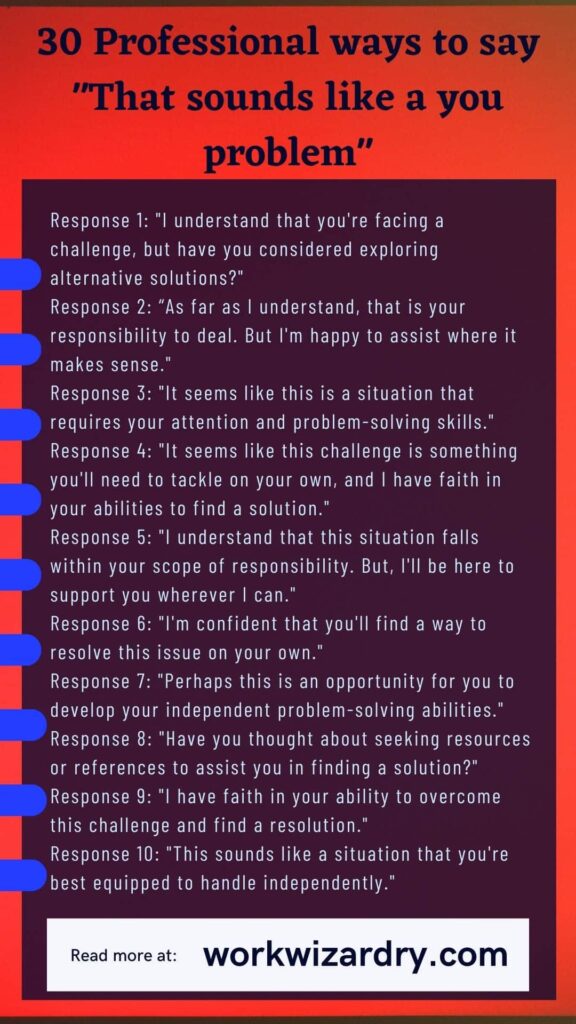In today’s professional world, effective communication is crucial for building successful relationships both inside and outside the workplace.
But what happens when you encounter a situation where someone’s problem is not your responsibility? How do you politely communicate that it is their issue to resolve without coming across as dismissive or rude?
And How to professionally say that sounds like a you problem? In this blog post, we will explore 30 professional ways to convey this message with tact and diplomacy, as well as provide some tips to help you navigate these situations with ease.
These responses and tips will help you navigate difficult conversations with ease and professionalism, while still effectively managing your workload and responsibilities.
Table of Contents
How to professionally say that sounds like a you problem?
As a professional, it’s important to communicate with empathy and understanding, even when faced with a situation where it may seem appropriate to say “sounds like a you problem.”
This phrase can come across as dismissive and uncaring, which is not the tone that you want to convey in a professional setting.
It is important to acknowledge and empathize with the individual’s situation before addressing their issue
One possible approach could be to say: “I understand your concern, and I am willing to help in any way I can. However, it’s important to note that this issue falls outside my area of expertise, and I’m afraid I’m not equipped to solve it.
Or simply you can professionally say something like: “I’m sorry to hear that, but I’m afraid it’s not within my area of responsibility or expertise.”
Workplace communication tips to improve your professional skills
Here are some tips and strategies for communicating effectively in the workplace:
Acknowledge the problem: Even if the issue seems trivial or unimportant to you, it’s important to acknowledge that it’s a problem for the person who brought it up. Take the time to listen and understand their perspective before responding.
Encourage and offer support:: Instead of dismissing the problem, offer support or inspire them to do their own. Even if it’s not directly your responsibility to solve the issue, you can offer suggestions or connect them with the appropriate resources.
Be mindful of tone: Tone is everything when it comes to effective communication. Make sure you’re using a tone that conveys empathy, understanding, and a willingness to help. Avoid using a tone that comes across as dismissive or condescending.
Be an active listener: Another approach could be to use active listening techniques to better understand the person’s perspective and concerns.
This can involve paraphrasing their concerns back to them to ensure that you understand their perspective, and actively seeking out their input on potential solutions.
By taking the time to understand their concerns and perspectives, you may be able to find a solution that works for everyone.
Maintain professionalism: In addition to language and active listening, it is also important to maintain a level of professionalism in all aspects of workplace communication, including body language and tone of voice.
This can involve maintaining a calm and respectful demeanor, even in the face of difficult situations or challenging personalities.
By modeling professionalism and respect, you may be able to deescalate tense situations and encourage a more collaborative and productive workplace environment.
30 Professional ways to say that sounds like a you problem
How do you professionally say That sounds like a you problem? Here are 30 Professional ways to say this isn’t my problem or sounds like a you problem:
Response 1: “I understand that you’re facing a challenge, but have you considered exploring alternative solutions?”
Response 2: “As far as I understand, that is your responsibility to deal. But I’m happy to assist where it makes sense.”
Response 3: “It seems like this is a situation that requires your attention and problem-solving skills.”
Response 4: “It seems like this challenge is something you’ll need to tackle on your own, and I have faith in your abilities to find a solution.”
Response 5: “I understand that this situation falls within your scope of responsibility. But, I’ll be here to support you wherever I can.”
Response 6: “I’m confident that you’ll find a way to resolve this issue on your own.”
Response 7: “Perhaps this is an opportunity for you to develop your independent problem-solving abilities.”
Response 8: “Have you thought about seeking resources or references to assist you in finding a solution?”
Response 9: “I have faith in your ability to overcome this challenge and find a resolution.”
Response 10: “This sounds like a situation that you’re best equipped to handle independently.”
Response 11: “I encourage you to take ownership of this problem and find a way to address it.”
Response 12: “I’m confident that you’ll be able to navigate this situation with your expertise and experience.”
Response 13: “It’s important to take responsibility for our own challenges and seek solutions independently.”
Response 14: “This could be an opportunity for growth and development in your problem-solving skills.”
Response 15: “I believe in your ability to overcome this challenge and find a suitable solution.”
Also read: 20 Professional ways to say No to extra work hours

Response 16: “Have you considered taking a step back and looking at the situation from a different perspective?”
Response 17: “This could be an opportunity to demonstrate your independence and resourcefulness.”
Response 18: “It’s important to take ownership of your challenges and work towards finding solutions independently.”
Response 19: “I’m confident that with your knowledge and expertise, you’ll be able to find a resolution to this challenge.”
Response 20: “Perhaps this is an opportunity to utilize your critical thinking and analytical skills.”
Response 21: “I understand that this situation is specific to your responsibilities, and I’m here to support you if it’s too necessary.
Response 22: “I understand that this issue requires your expertise, and I’m here to help in any way I can to make it easier for you.”
Response 23: “I know you’re up to the task, and I’ll be here to support you in any way I can while you navigate this situation.”
Response 24: “I appreciate that you’re the expert in this area, and I know you’ll handle it with your usual skill and professionalism.”
Response 25: “Wish I could assist you in any way I can – to make this situation easier for you.” However, I believe in your problem-solving skills that you are good on your own.
Response 26: “I understand that this situation may present some difficulties for you, but I am confident that you have the skills and expertise to handle it effectively.”
Response 27: “While I can appreciate the difficulty you’re encountering, I believe that it would be best addressed by those who have the necessary resources and expertise.”
Response 28: “It seems that this situation is specific to your role, and I would like to offer my support and resources to help you find a solution.”
Response 29: “I understand that this may require a lot of effort and attention on your part, and I would like to offer my support and understanding as you tackle it.”
Response 30: “I have faith in your abilities, and I am here to provide any resources or assistance you may need to handle this situation with success.”
Final thoughts:
In conclusion, communication is an essential aspect of professionalism, and how we convey messages can significantly impact our working relationships.
While it can be tempting to use flippant or dismissive language, it is crucial to remain empathetic, calm, and solution-oriented when communicating with others.
By doing so, we can maintain positive working relationships, foster mutual respect, and achieve our professional goals.





